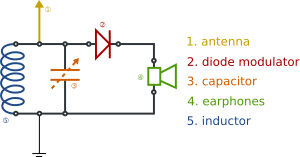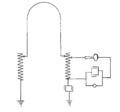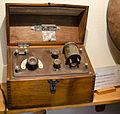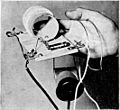Crystal radio facts for kids
A crystal radio (also called a crystal set) is a super simple radio that doesn't need any batteries to work! It gets its power directly from radio waves.
Imagine a long wire, called an antenna. This antenna catches tiny signals from nearby radio transmitters. These signals are strong enough to power a special part called a crystal diode. This diode helps turn the radio signals into sound. You can then hear the sound through an earphone or a small headset. Crystal radios usually pick up AM radio stations.
Contents
History of Crystal Radios
Crystal radios have been around for a long time. They were very popular in the early days of radio.
Early Radio Days
When radio broadcasting first started, many people built crystal radios. They were often made by amateurs (people who do something for fun, not as a job). They were also popular with people who couldn't afford more expensive radios.
Crystal Radios During Hard Times
Crystal radios became popular again during the Great Depression. This was a time when many people didn't have much money. Since crystal radios didn't need batteries, they were a cheap way to listen to the news and entertainment.
During World War II, American soldiers even built "foxhole radios." They used simple items like a razor blade and a pencil tip instead of a special crystal. This was smart because German and Italian troops had equipment that could detect regular radios. A simple crystal radio was harder to find.
Crystal Radios as a Hobby
After World War II, many people, especially children, started building crystal sets as science projects or hobbies. It was a fun way to learn about electronics. Later, during the Vietnam War, prisoners of war also built simple radios. Soldiers sometimes used Slinky springs as antennas!
Today, there are still hobby clubs for people who enjoy building crystal radios. It's a great way to explore how radio works.
How a Crystal Radio Works
A crystal radio works by using a few key parts to catch and play radio waves.
Catching Radio Waves
First, the antenna catches radio waves that are traveling through the air. These waves are actually tiny electrical signals. The longer the antenna, the more signals it can catch.
Tuning In
Next, the radio needs to pick out one specific radio station. It does this using a coil of wire and sometimes a capacitor. These parts work together to "tune" the radio to a certain frequency, just like you tune a regular radio to your favorite station.
Making Sound
The most important part is the crystal diode. This tiny component acts like a one-way gate for electricity. When the radio signal passes through the diode, it changes the signal in a special way (this is called demodulation). This change turns the radio signal into an electrical signal that your ear can hear.
Finally, this electrical signal goes to a sensitive earphone or headset. The earphone turns the electrical signal into sound waves that you can hear. Because the signals are very weak, you need special earphones that don't require much power.
Images for kids
-
US Bureau of Standards 1922 Circular 120 "A simple homemade radio receiving outfit" taught Americans how to build a crystal radio.
-
Crystal radio (1915) kept at the Museum of the radio - Monteceneri (Switzerland)
-
Pictorial diagram from 1922 showing the circuit of a crystal radio. This common circuit did not use a tuning capacitor, but used the capacitance of the antenna to form the tuned circuit with the coil. The detector was a cat whisker detector, consisting of a piece of galena with a thin wire in contact with it on a part of the crystal, making a diode contact
-
Germanium diode used in modern crystal radios (about 3 mm long)
See also
 In Spanish: Radio de galena para niños
In Spanish: Radio de galena para niños
















